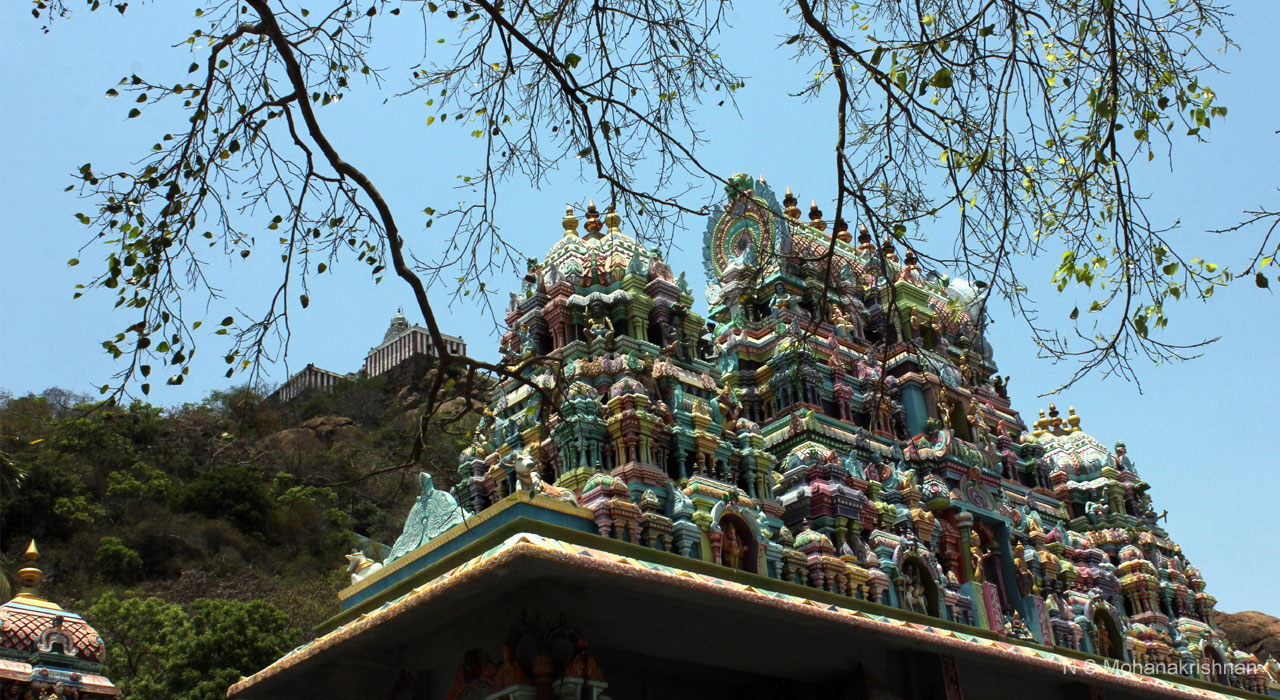Vedagireeswarar, facing east
Glorified Shiva Temple – Thirukazhukundram

God
Goddess
Thirupurasundari, facing east at the base temple
Other Deities
to be updated
Thirukazhukundram is a hill temple which can be reached by a stiff climb up 562 steps. At the base are Vinayaka and Ayyappa. On the way up there is a small shrine with idols of Ganesha, Muruga and Parvati hugging Shiva Lingam. Vedagireeswarar at the top is a Swayambu Lingam (Self occurring). On the way down on the other side that you climb up there is an ancient cave temple carved out of a single stone with the holy trinity of Hinduism – Shiva flanked by Brahma and Vishnu. To the east of the temple is a shrine for Naalvar, the four great saivite saints. Two vultures have been coming here to Thirukazhukundram for centuries to partake sweet rice offered to them by a temple priest. From pictures these appear to be Egyptian Vultures. Their schedule has been irregular at times and more so in recent times.
Sangu Theertham. There are actually 12 Theerthams common to Vedagireeswarar and Bakthawatsaleswarar Thirukazhukundram (1. Indra Theertham, 2. Sambu Theertham 3. Rudra Theertham, 4. Vashishta Theertham, 5. Meygnyana Theertham, 6. Agasthiya Theertham, 7. Markandeya Theertham, 8. Kaushika Theertham, 9. Nandi Theertham, 10. Varuna theertham, 11. Agalikai Theertham, 12. Pakshi Theertham)
Sacred Tree (Sthala Vriksham) – Plantain



History
All three great saivite saints Thirugnanasambandar, Thirunavukkarasar, Sundarar (7-8th Century CE) and Manickavasagar (9th century CE, who wrote the Thirivasagam amongst other literary works) have visited and sung praises for the Lord here at Thirukazhukundram. Arunagirinadar (15th Century CE) has sung the praise of Lord Muruga here. The cave temple mentioned above was carved between 610-640 CE started by Mahendra Verma and completed by Narasimha Verma. The temple, its history and legend has been mentioned in several ancient literatures.
Stone inscriptions found at Thirukazhukundram temple are as follows:
A stone inscription dating back to 642 CE mentions the cave temple’s creation.
Narasimha Verma (630-668 CE) mentions this lord as Sreemalai Mel Moolasthanathu Perumaanadigal.
1028 CE inscription of Rajendra I period mentions the lord as Sree Moolasthanathu Desavidanga Devar.
1214 CE inscription of Kulothunga III period mentions the lord as Thirumalai Mel Udayavar.
1376 CE inscription of Veerapokkana Udayar of Vijayanagar mentions the lord as Desavidanga Perumaan.
Inscriptions mention the contributions of Rajendra I, Rajarajan, Rajendra II, Veera Rajendran, Rajanarayana Sambuvarayan among others.
Conversion as a stone temple was done by Saathan Maheebalan as per an inscription.
The front mantapa was constructed by Kathavarayan (thought to be a Sambuvarayar descendant) in 1388 CE.
Legend
When Sage Markandeya wanted to perform ablutions for the Shiva Lingam (Theerthagireeswarar) on the banks of the Sangu Theertham tank here he could not locate a suitable vessel. Suddenly a Conch floated up in the water with a humming sound. He is believed to have used the conch for the purpose. The administration of the temples has preserved about 1000 Conches which are said to float up approximately every 12 years. These are used to perform Ablutions to the lord at Vedagireeswarar Thirukazhukundram once a year. The last such conch surfaced in 2011. Vedagireeswarar was worshiped by Indra, his court dancer Thilothama, Garuda, Ashtavasus, Rudras and the Vedas themselves. The four Vedas are present here as Hills and the temple is located on top of the hill said to represent Rig Veda. Two eagles have been visiting a particular spot in this temple to partake food from the priest here for centuries. These eagles are considered to be two sages cursed by Lord Shiva, Pusha and Vidhadha, to become vultures till the end of Kaliyuga after which they can achieve salvation. Lord Indra is believed to worship the Shiva here even today as a stroke of lightning which passes through a hole in the sanctum sanctorum and around the Lingam. The morning after this happens when the doors are opened immense and unbearable heat is said to emanate from the sanctum sanctorum. This has been scientifically verified in the past. The Theertham here is believed to become the confluence of all major rivers on a particular day which is celebrated as Maha Pushkaram at Thirukazhukundram.
Directions
Vedagireeswarar Thirukazhukundram is in the northern side of the town and is visible from miles around. There is ample paid parking below from where you start your climb up. It is advisable to climb up early before it gets hot and wait up for the vultures as the 562 steps can be tough. The temple closes at 12.30 PM and opens again in the evening at 4 pm, plan your trip accordingly.
Stay and Food
None locally except tea and snack shops. A small restaurant is available just below the climb to Vedagireeswarar Thirukazhukundram.
